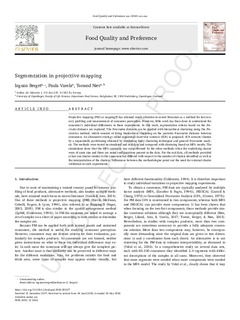| dc.contributor.author | Berget, Ingunn | |
| dc.contributor.author | Varela, Paula | |
| dc.contributor.author | Næs, Tormod | |
| dc.date.accessioned | 2018-10-03T06:23:51Z | |
| dc.date.available | 2018-10-03T06:23:51Z | |
| dc.date.created | 2018-09-25T08:49:02Z | |
| dc.date.issued | 2019 | |
| dc.identifier.citation | Food Quality and Preference. 2019, 71 8-20. | nb_NO |
| dc.identifier.issn | 0950-3293 | |
| dc.identifier.uri | http://hdl.handle.net/11250/2565938 | |
| dc.description.abstract | Projective mapping (PM) or napping® has attained much attention in recent literature as a method for fast sensory profiling and measurement of consumer perception. However, little work has been done to understand the consumer’s individual differences in these experiments. In this work, segmentation criteria based on the Procrustes distance are explored. The Procrustes distance can be applied with hierarchical clustering using the Proclustrees method, which consists of doing hierarchical clustering on the pairwise Procrustes distance between consumers. An alternative strategy called sequential clusterwise rotations (SCR) is proposed. SCR extracts clusters by a sequentially partitioning obtained by combining fuzzy clustering techniques and general Procrustes analysis. The methods were tested on simulated and real data and compared with clustering based on MFA results. The simulations show that the MFA approach was outperformed by the other methods when the underlying classes were of same size and there are noise configurations present in the data. For the real data, all methods provided at last one cluster similar to the consensus but differed with respect to the number of clusters identified as well as the interpretation of the clusters. Differences between the methodologies point out the need for external cluster validation in such experiments. | |
| dc.language.iso | eng | nb_NO |
| dc.title | Segmentation in projective mapping | nb_NO |
| dc.title.alternative | Segmentation in projective mapping | nb_NO |
| dc.type | Journal article | nb_NO |
| dc.type | Peer reviewed | nb_NO |
| dc.description.version | acceptedVersion | |
| dc.source.pagenumber | 8-20 | nb_NO |
| dc.source.volume | 71 | nb_NO |
| dc.source.journal | Food Quality and Preference | nb_NO |
| dc.identifier.doi | 10.1016/j.foodqual.2018.05.007 | |
| dc.identifier.cristin | 1613192 | |
| dc.relation.project | Norges forskningsråd: 233684 | nb_NO |
| dc.relation.project | Nofima AS: 10841 | nb_NO |
| dc.relation.project | Norges forskningsråd: 262308 | nb_NO |
| dc.relation.project | Nofima AS: 201702 | nb_NO |
| cristin.unitcode | 7543,3,2,0 | |
| cristin.unitcode | 7543,3,3,0 | |
| cristin.unitname | Råvare og prosess | |
| cristin.unitname | Sensorikk, forbruker og innovasjon | |
| cristin.ispublished | true | |
| cristin.fulltext | postprint | |
| cristin.qualitycode | 1 | |
